Corporations and Business Law Case Study Assignment - University
VerifiedAdded on 2022/11/18
|9
|2365
|387
Case Study
AI Summary
This case study delves into two distinct scenarios within corporations and business law. Part A examines the legal responsibilities of a company (Swimming Co) for the actions of its sales manager (Martin), focusing on agency law, vicarious liability, and breach of duty. The analysis considers whether the company is liable for Martin's actions, whether Martin breached his duties, and the implications of his actions, including setting up a competing business. Part B focuses on partnership law, analyzing a business (LuSeKo) involving three partners (Koo, Lucy, and Seamus). The study addresses issues such as the existence of a partnership, the liability of partners for business debts, breaches of partnership duties (Lucy's actions), the impact of a partner's death, and the identification of partners in a legal action, including how the partnership's property is determined and used. The case study applies relevant legal principles from both agency and partnership law to provide conclusions for each scenario.
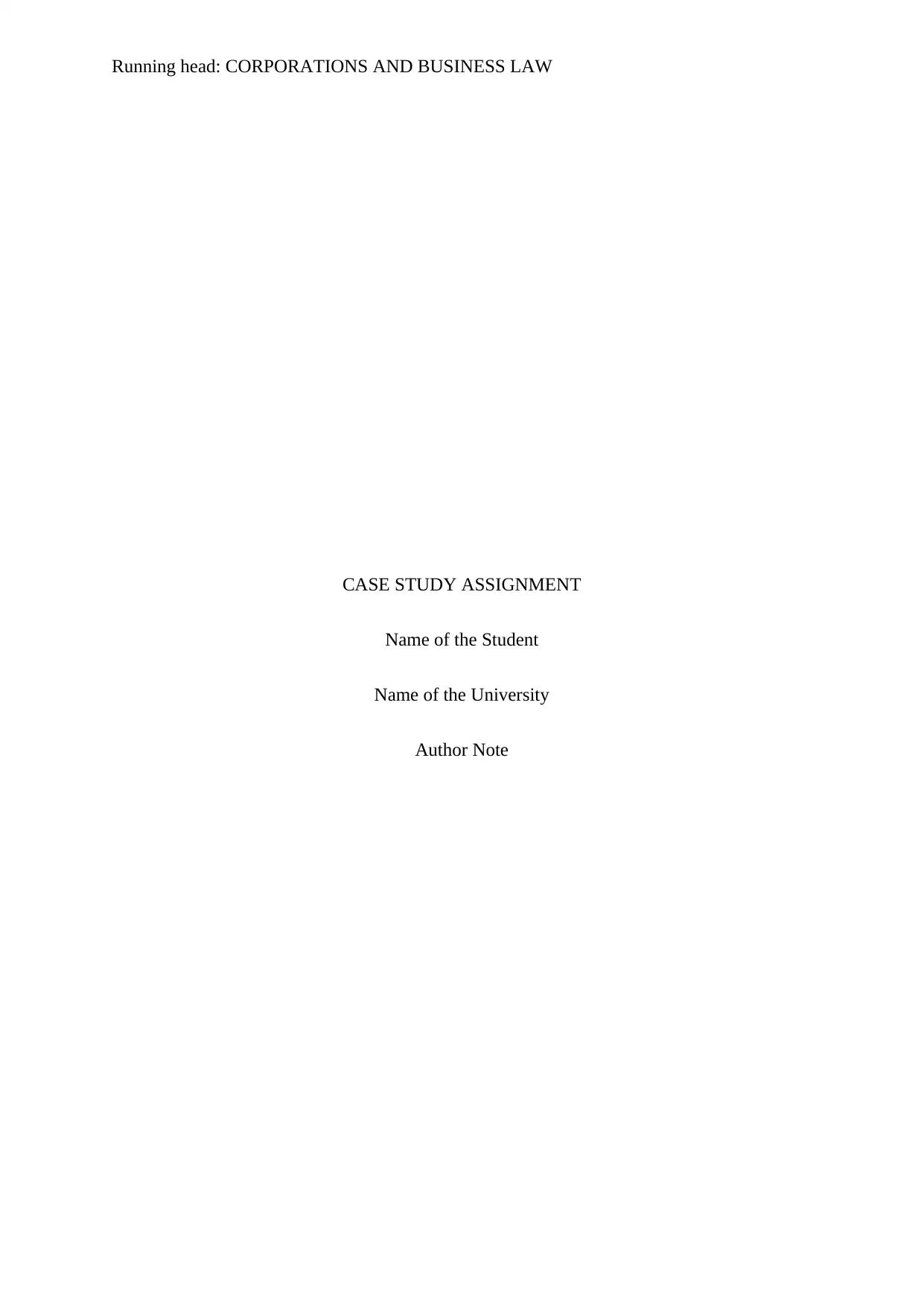
Running head: CORPORATIONS AND BUSINESS LAW
CASE STUDY ASSIGNMENT
Name of the Student
Name of the University
Author Note
CASE STUDY ASSIGNMENT
Name of the Student
Name of the University
Author Note
Paraphrase This Document
Need a fresh take? Get an instant paraphrase of this document with our AI Paraphraser
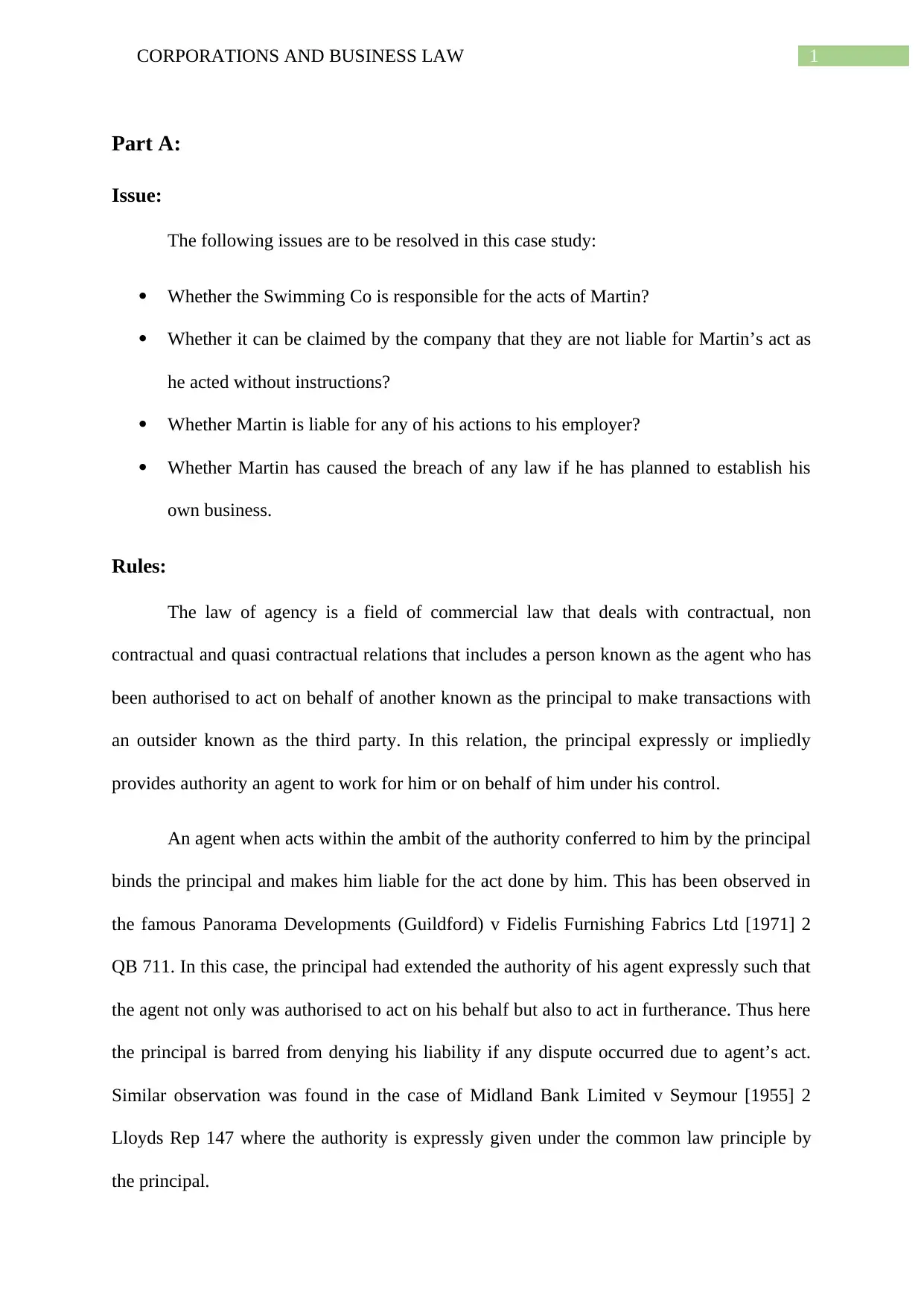
1CORPORATIONS AND BUSINESS LAW
Part A:
Issue:
The following issues are to be resolved in this case study:
Whether the Swimming Co is responsible for the acts of Martin?
Whether it can be claimed by the company that they are not liable for Martin’s act as
he acted without instructions?
Whether Martin is liable for any of his actions to his employer?
Whether Martin has caused the breach of any law if he has planned to establish his
own business.
Rules:
The law of agency is a field of commercial law that deals with contractual, non
contractual and quasi contractual relations that includes a person known as the agent who has
been authorised to act on behalf of another known as the principal to make transactions with
an outsider known as the third party. In this relation, the principal expressly or impliedly
provides authority an agent to work for him or on behalf of him under his control.
An agent when acts within the ambit of the authority conferred to him by the principal
binds the principal and makes him liable for the act done by him. This has been observed in
the famous Panorama Developments (Guildford) v Fidelis Furnishing Fabrics Ltd [1971] 2
QB 711. In this case, the principal had extended the authority of his agent expressly such that
the agent not only was authorised to act on his behalf but also to act in furtherance. Thus here
the principal is barred from denying his liability if any dispute occurred due to agent’s act.
Similar observation was found in the case of Midland Bank Limited v Seymour [1955] 2
Lloyds Rep 147 where the authority is expressly given under the common law principle by
the principal.
Part A:
Issue:
The following issues are to be resolved in this case study:
Whether the Swimming Co is responsible for the acts of Martin?
Whether it can be claimed by the company that they are not liable for Martin’s act as
he acted without instructions?
Whether Martin is liable for any of his actions to his employer?
Whether Martin has caused the breach of any law if he has planned to establish his
own business.
Rules:
The law of agency is a field of commercial law that deals with contractual, non
contractual and quasi contractual relations that includes a person known as the agent who has
been authorised to act on behalf of another known as the principal to make transactions with
an outsider known as the third party. In this relation, the principal expressly or impliedly
provides authority an agent to work for him or on behalf of him under his control.
An agent when acts within the ambit of the authority conferred to him by the principal
binds the principal and makes him liable for the act done by him. This has been observed in
the famous Panorama Developments (Guildford) v Fidelis Furnishing Fabrics Ltd [1971] 2
QB 711. In this case, the principal had extended the authority of his agent expressly such that
the agent not only was authorised to act on his behalf but also to act in furtherance. Thus here
the principal is barred from denying his liability if any dispute occurred due to agent’s act.
Similar observation was found in the case of Midland Bank Limited v Seymour [1955] 2
Lloyds Rep 147 where the authority is expressly given under the common law principle by
the principal.
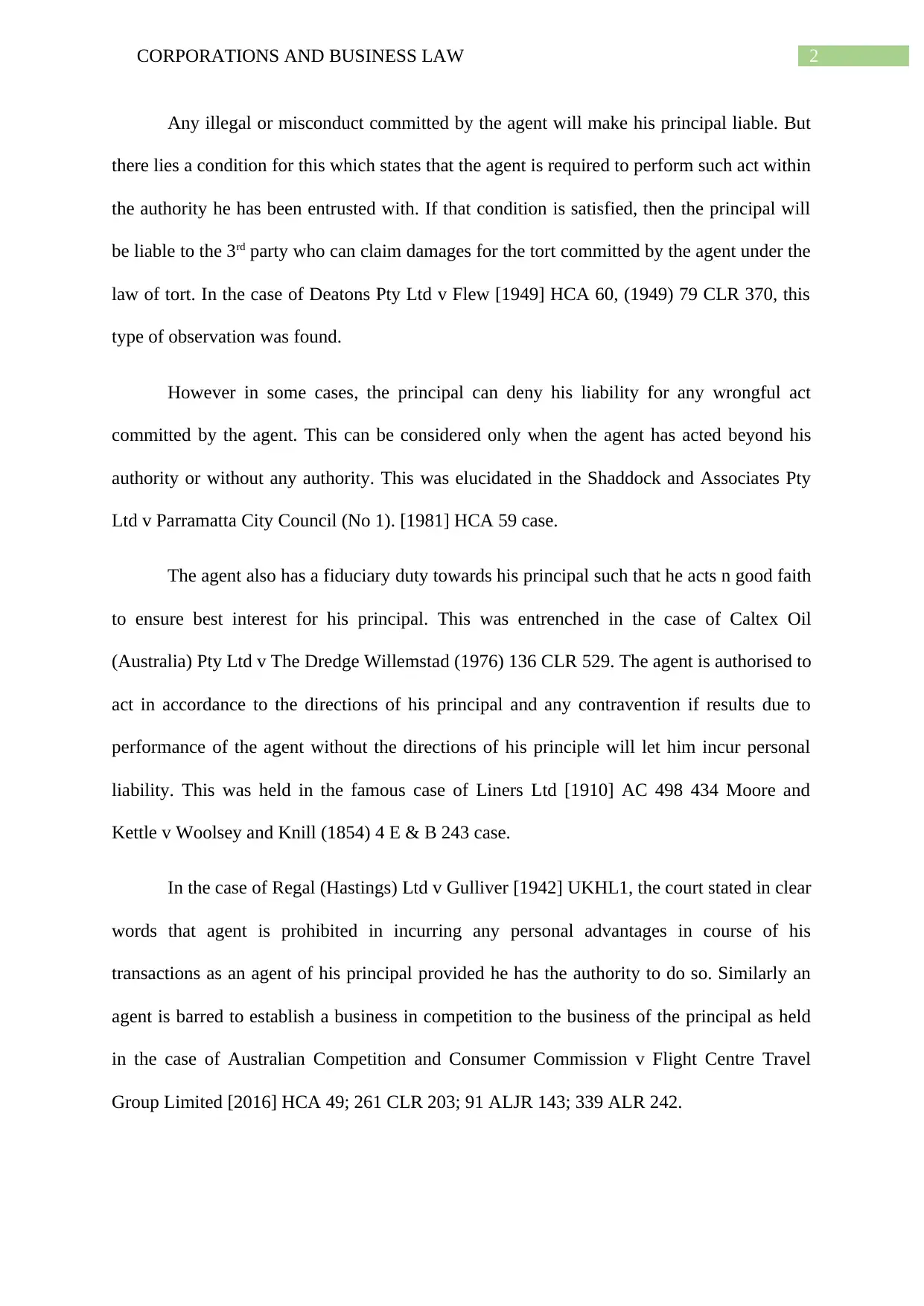
2CORPORATIONS AND BUSINESS LAW
Any illegal or misconduct committed by the agent will make his principal liable. But
there lies a condition for this which states that the agent is required to perform such act within
the authority he has been entrusted with. If that condition is satisfied, then the principal will
be liable to the 3rd party who can claim damages for the tort committed by the agent under the
law of tort. In the case of Deatons Pty Ltd v Flew [1949] HCA 60, (1949) 79 CLR 370, this
type of observation was found.
However in some cases, the principal can deny his liability for any wrongful act
committed by the agent. This can be considered only when the agent has acted beyond his
authority or without any authority. This was elucidated in the Shaddock and Associates Pty
Ltd v Parramatta City Council (No 1). [1981] HCA 59 case.
The agent also has a fiduciary duty towards his principal such that he acts n good faith
to ensure best interest for his principal. This was entrenched in the case of Caltex Oil
(Australia) Pty Ltd v The Dredge Willemstad (1976) 136 CLR 529. The agent is authorised to
act in accordance to the directions of his principal and any contravention if results due to
performance of the agent without the directions of his principle will let him incur personal
liability. This was held in the famous case of Liners Ltd [1910] AC 498 434 Moore and
Kettle v Woolsey and Knill (1854) 4 E & B 243 case.
In the case of Regal (Hastings) Ltd v Gulliver [1942] UKHL1, the court stated in clear
words that agent is prohibited in incurring any personal advantages in course of his
transactions as an agent of his principal provided he has the authority to do so. Similarly an
agent is barred to establish a business in competition to the business of the principal as held
in the case of Australian Competition and Consumer Commission v Flight Centre Travel
Group Limited [2016] HCA 49; 261 CLR 203; 91 ALJR 143; 339 ALR 242.
Any illegal or misconduct committed by the agent will make his principal liable. But
there lies a condition for this which states that the agent is required to perform such act within
the authority he has been entrusted with. If that condition is satisfied, then the principal will
be liable to the 3rd party who can claim damages for the tort committed by the agent under the
law of tort. In the case of Deatons Pty Ltd v Flew [1949] HCA 60, (1949) 79 CLR 370, this
type of observation was found.
However in some cases, the principal can deny his liability for any wrongful act
committed by the agent. This can be considered only when the agent has acted beyond his
authority or without any authority. This was elucidated in the Shaddock and Associates Pty
Ltd v Parramatta City Council (No 1). [1981] HCA 59 case.
The agent also has a fiduciary duty towards his principal such that he acts n good faith
to ensure best interest for his principal. This was entrenched in the case of Caltex Oil
(Australia) Pty Ltd v The Dredge Willemstad (1976) 136 CLR 529. The agent is authorised to
act in accordance to the directions of his principal and any contravention if results due to
performance of the agent without the directions of his principle will let him incur personal
liability. This was held in the famous case of Liners Ltd [1910] AC 498 434 Moore and
Kettle v Woolsey and Knill (1854) 4 E & B 243 case.
In the case of Regal (Hastings) Ltd v Gulliver [1942] UKHL1, the court stated in clear
words that agent is prohibited in incurring any personal advantages in course of his
transactions as an agent of his principal provided he has the authority to do so. Similarly an
agent is barred to establish a business in competition to the business of the principal as held
in the case of Australian Competition and Consumer Commission v Flight Centre Travel
Group Limited [2016] HCA 49; 261 CLR 203; 91 ALJR 143; 339 ALR 242.
⊘ This is a preview!⊘
Do you want full access?
Subscribe today to unlock all pages.

Trusted by 1+ million students worldwide
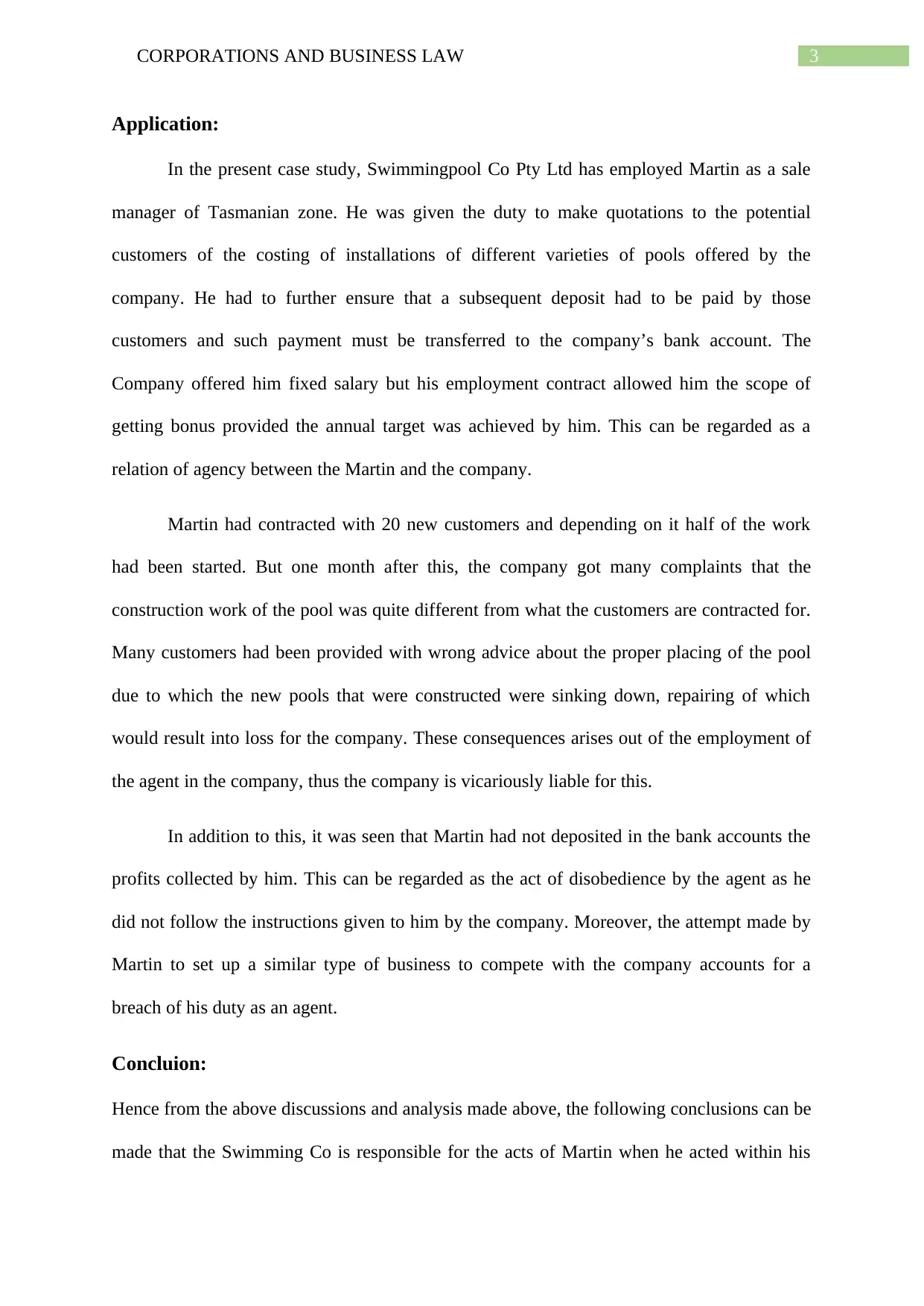
3CORPORATIONS AND BUSINESS LAW
Application:
In the present case study, Swimmingpool Co Pty Ltd has employed Martin as a sale
manager of Tasmanian zone. He was given the duty to make quotations to the potential
customers of the costing of installations of different varieties of pools offered by the
company. He had to further ensure that a subsequent deposit had to be paid by those
customers and such payment must be transferred to the company’s bank account. The
Company offered him fixed salary but his employment contract allowed him the scope of
getting bonus provided the annual target was achieved by him. This can be regarded as a
relation of agency between the Martin and the company.
Martin had contracted with 20 new customers and depending on it half of the work
had been started. But one month after this, the company got many complaints that the
construction work of the pool was quite different from what the customers are contracted for.
Many customers had been provided with wrong advice about the proper placing of the pool
due to which the new pools that were constructed were sinking down, repairing of which
would result into loss for the company. These consequences arises out of the employment of
the agent in the company, thus the company is vicariously liable for this.
In addition to this, it was seen that Martin had not deposited in the bank accounts the
profits collected by him. This can be regarded as the act of disobedience by the agent as he
did not follow the instructions given to him by the company. Moreover, the attempt made by
Martin to set up a similar type of business to compete with the company accounts for a
breach of his duty as an agent.
Concluion:
Hence from the above discussions and analysis made above, the following conclusions can be
made that the Swimming Co is responsible for the acts of Martin when he acted within his
Application:
In the present case study, Swimmingpool Co Pty Ltd has employed Martin as a sale
manager of Tasmanian zone. He was given the duty to make quotations to the potential
customers of the costing of installations of different varieties of pools offered by the
company. He had to further ensure that a subsequent deposit had to be paid by those
customers and such payment must be transferred to the company’s bank account. The
Company offered him fixed salary but his employment contract allowed him the scope of
getting bonus provided the annual target was achieved by him. This can be regarded as a
relation of agency between the Martin and the company.
Martin had contracted with 20 new customers and depending on it half of the work
had been started. But one month after this, the company got many complaints that the
construction work of the pool was quite different from what the customers are contracted for.
Many customers had been provided with wrong advice about the proper placing of the pool
due to which the new pools that were constructed were sinking down, repairing of which
would result into loss for the company. These consequences arises out of the employment of
the agent in the company, thus the company is vicariously liable for this.
In addition to this, it was seen that Martin had not deposited in the bank accounts the
profits collected by him. This can be regarded as the act of disobedience by the agent as he
did not follow the instructions given to him by the company. Moreover, the attempt made by
Martin to set up a similar type of business to compete with the company accounts for a
breach of his duty as an agent.
Concluion:
Hence from the above discussions and analysis made above, the following conclusions can be
made that the Swimming Co is responsible for the acts of Martin when he acted within his
Paraphrase This Document
Need a fresh take? Get an instant paraphrase of this document with our AI Paraphraser
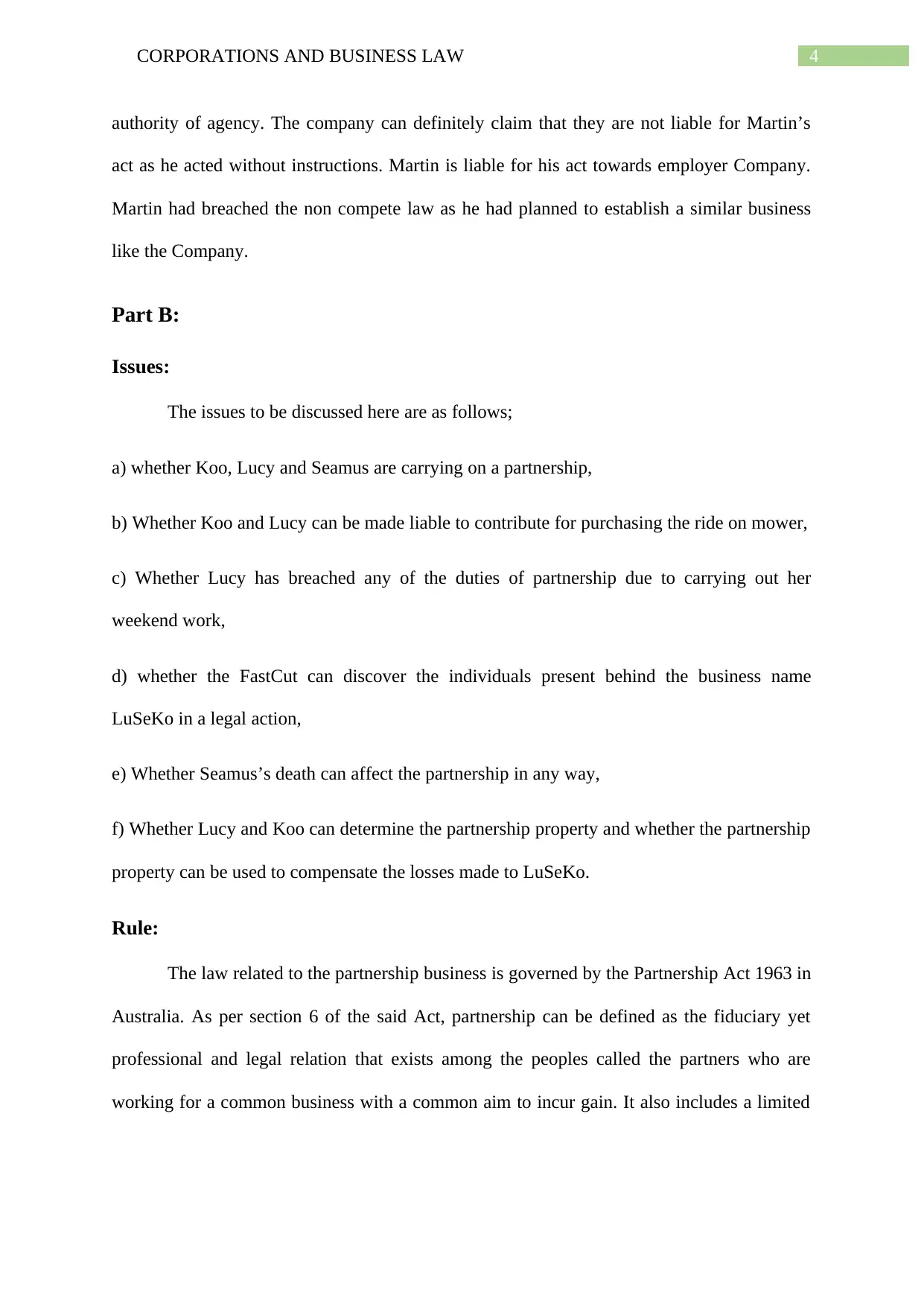
4CORPORATIONS AND BUSINESS LAW
authority of agency. The company can definitely claim that they are not liable for Martin’s
act as he acted without instructions. Martin is liable for his act towards employer Company.
Martin had breached the non compete law as he had planned to establish a similar business
like the Company.
Part B:
Issues:
The issues to be discussed here are as follows;
a) whether Koo, Lucy and Seamus are carrying on a partnership,
b) Whether Koo and Lucy can be made liable to contribute for purchasing the ride on mower,
c) Whether Lucy has breached any of the duties of partnership due to carrying out her
weekend work,
d) whether the FastCut can discover the individuals present behind the business name
LuSeKo in a legal action,
e) Whether Seamus’s death can affect the partnership in any way,
f) Whether Lucy and Koo can determine the partnership property and whether the partnership
property can be used to compensate the losses made to LuSeKo.
Rule:
The law related to the partnership business is governed by the Partnership Act 1963 in
Australia. As per section 6 of the said Act, partnership can be defined as the fiduciary yet
professional and legal relation that exists among the peoples called the partners who are
working for a common business with a common aim to incur gain. It also includes a limited
authority of agency. The company can definitely claim that they are not liable for Martin’s
act as he acted without instructions. Martin is liable for his act towards employer Company.
Martin had breached the non compete law as he had planned to establish a similar business
like the Company.
Part B:
Issues:
The issues to be discussed here are as follows;
a) whether Koo, Lucy and Seamus are carrying on a partnership,
b) Whether Koo and Lucy can be made liable to contribute for purchasing the ride on mower,
c) Whether Lucy has breached any of the duties of partnership due to carrying out her
weekend work,
d) whether the FastCut can discover the individuals present behind the business name
LuSeKo in a legal action,
e) Whether Seamus’s death can affect the partnership in any way,
f) Whether Lucy and Koo can determine the partnership property and whether the partnership
property can be used to compensate the losses made to LuSeKo.
Rule:
The law related to the partnership business is governed by the Partnership Act 1963 in
Australia. As per section 6 of the said Act, partnership can be defined as the fiduciary yet
professional and legal relation that exists among the peoples called the partners who are
working for a common business with a common aim to incur gain. It also includes a limited
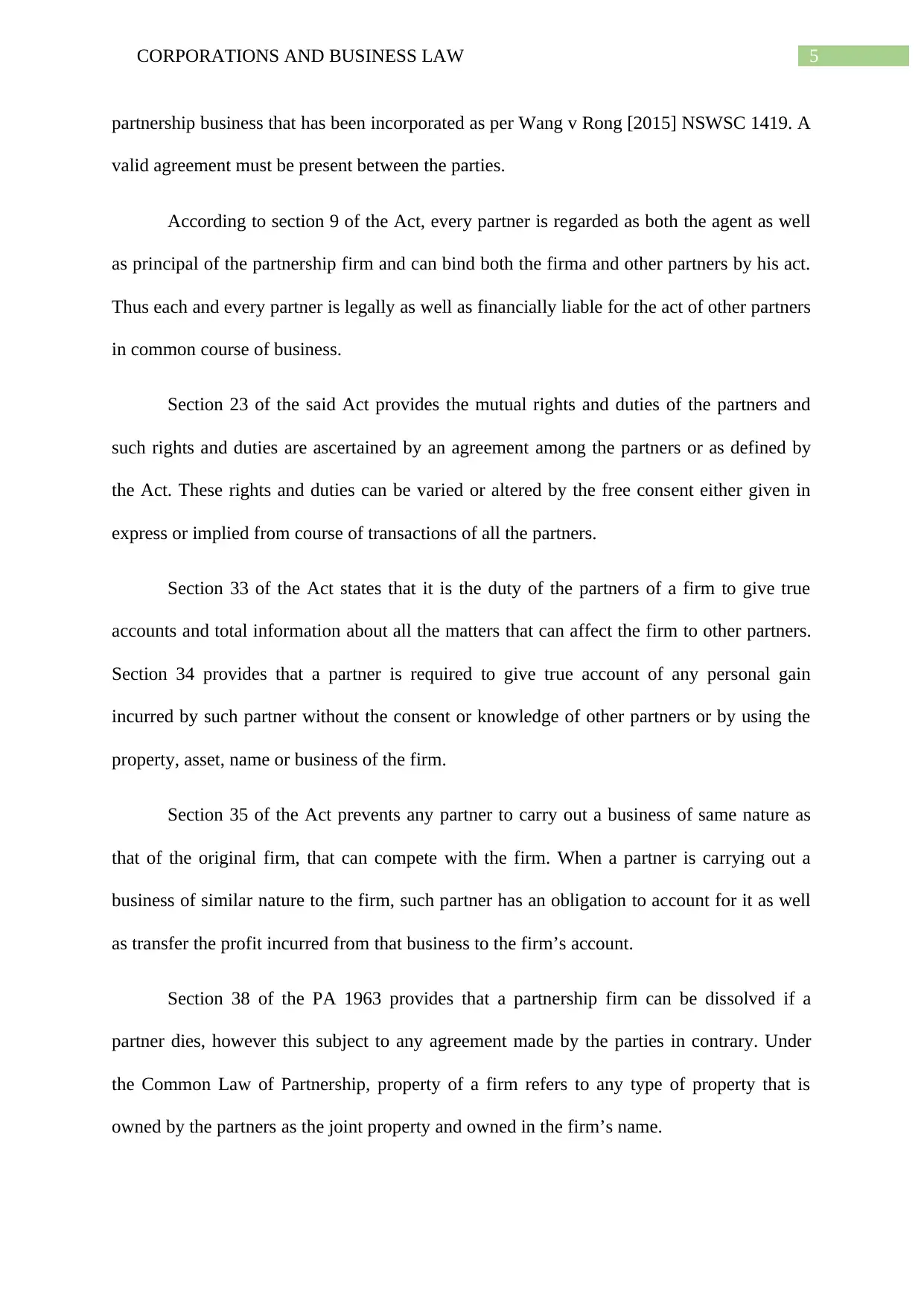
5CORPORATIONS AND BUSINESS LAW
partnership business that has been incorporated as per Wang v Rong [2015] NSWSC 1419. A
valid agreement must be present between the parties.
According to section 9 of the Act, every partner is regarded as both the agent as well
as principal of the partnership firm and can bind both the firma and other partners by his act.
Thus each and every partner is legally as well as financially liable for the act of other partners
in common course of business.
Section 23 of the said Act provides the mutual rights and duties of the partners and
such rights and duties are ascertained by an agreement among the partners or as defined by
the Act. These rights and duties can be varied or altered by the free consent either given in
express or implied from course of transactions of all the partners.
Section 33 of the Act states that it is the duty of the partners of a firm to give true
accounts and total information about all the matters that can affect the firm to other partners.
Section 34 provides that a partner is required to give true account of any personal gain
incurred by such partner without the consent or knowledge of other partners or by using the
property, asset, name or business of the firm.
Section 35 of the Act prevents any partner to carry out a business of same nature as
that of the original firm, that can compete with the firm. When a partner is carrying out a
business of similar nature to the firm, such partner has an obligation to account for it as well
as transfer the profit incurred from that business to the firm’s account.
Section 38 of the PA 1963 provides that a partnership firm can be dissolved if a
partner dies, however this subject to any agreement made by the parties in contrary. Under
the Common Law of Partnership, property of a firm refers to any type of property that is
owned by the partners as the joint property and owned in the firm’s name.
partnership business that has been incorporated as per Wang v Rong [2015] NSWSC 1419. A
valid agreement must be present between the parties.
According to section 9 of the Act, every partner is regarded as both the agent as well
as principal of the partnership firm and can bind both the firma and other partners by his act.
Thus each and every partner is legally as well as financially liable for the act of other partners
in common course of business.
Section 23 of the said Act provides the mutual rights and duties of the partners and
such rights and duties are ascertained by an agreement among the partners or as defined by
the Act. These rights and duties can be varied or altered by the free consent either given in
express or implied from course of transactions of all the partners.
Section 33 of the Act states that it is the duty of the partners of a firm to give true
accounts and total information about all the matters that can affect the firm to other partners.
Section 34 provides that a partner is required to give true account of any personal gain
incurred by such partner without the consent or knowledge of other partners or by using the
property, asset, name or business of the firm.
Section 35 of the Act prevents any partner to carry out a business of same nature as
that of the original firm, that can compete with the firm. When a partner is carrying out a
business of similar nature to the firm, such partner has an obligation to account for it as well
as transfer the profit incurred from that business to the firm’s account.
Section 38 of the PA 1963 provides that a partnership firm can be dissolved if a
partner dies, however this subject to any agreement made by the parties in contrary. Under
the Common Law of Partnership, property of a firm refers to any type of property that is
owned by the partners as the joint property and owned in the firm’s name.
⊘ This is a preview!⊘
Do you want full access?
Subscribe today to unlock all pages.

Trusted by 1+ million students worldwide
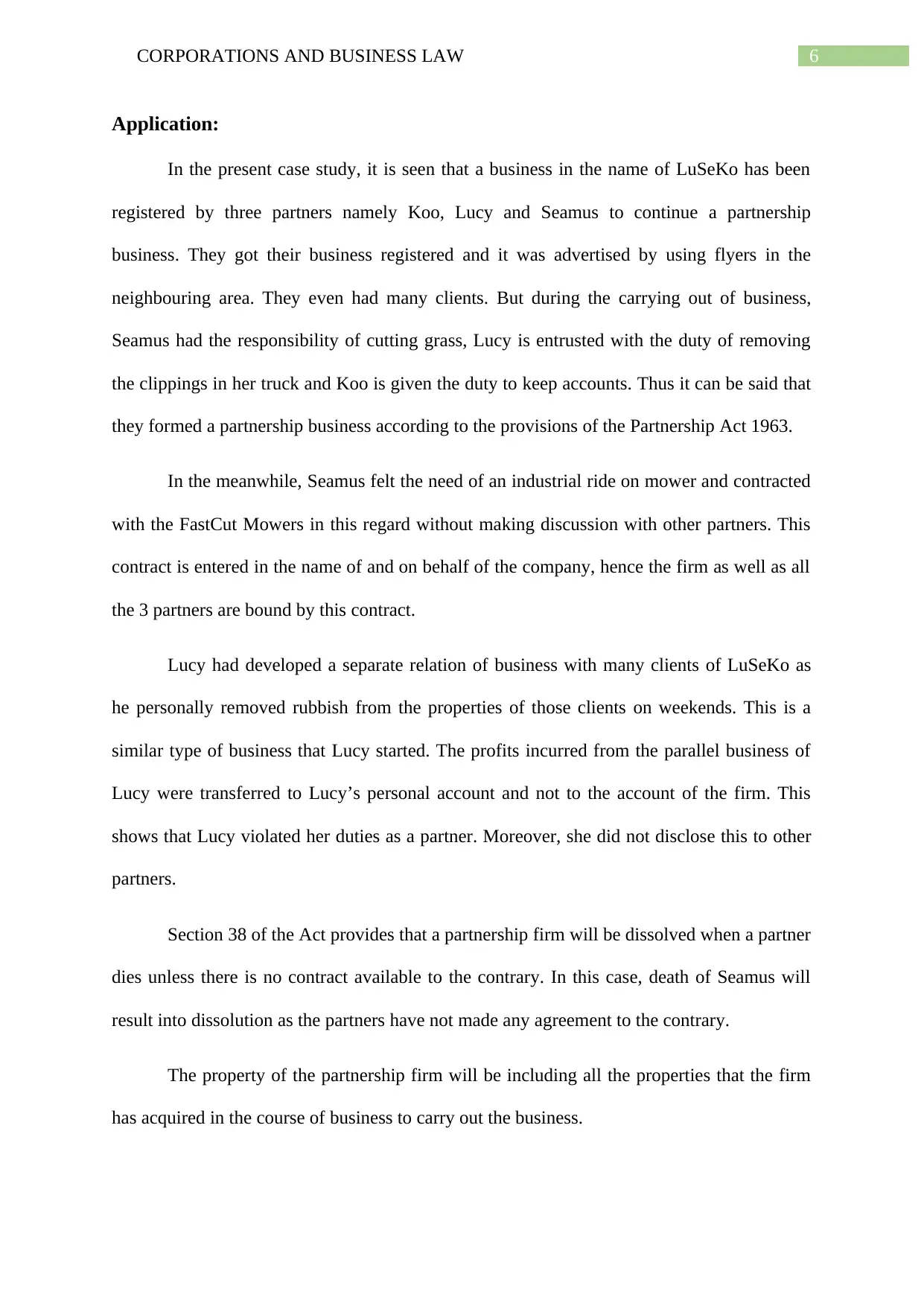
6CORPORATIONS AND BUSINESS LAW
Application:
In the present case study, it is seen that a business in the name of LuSeKo has been
registered by three partners namely Koo, Lucy and Seamus to continue a partnership
business. They got their business registered and it was advertised by using flyers in the
neighbouring area. They even had many clients. But during the carrying out of business,
Seamus had the responsibility of cutting grass, Lucy is entrusted with the duty of removing
the clippings in her truck and Koo is given the duty to keep accounts. Thus it can be said that
they formed a partnership business according to the provisions of the Partnership Act 1963.
In the meanwhile, Seamus felt the need of an industrial ride on mower and contracted
with the FastCut Mowers in this regard without making discussion with other partners. This
contract is entered in the name of and on behalf of the company, hence the firm as well as all
the 3 partners are bound by this contract.
Lucy had developed a separate relation of business with many clients of LuSeKo as
he personally removed rubbish from the properties of those clients on weekends. This is a
similar type of business that Lucy started. The profits incurred from the parallel business of
Lucy were transferred to Lucy’s personal account and not to the account of the firm. This
shows that Lucy violated her duties as a partner. Moreover, she did not disclose this to other
partners.
Section 38 of the Act provides that a partnership firm will be dissolved when a partner
dies unless there is no contract available to the contrary. In this case, death of Seamus will
result into dissolution as the partners have not made any agreement to the contrary.
The property of the partnership firm will be including all the properties that the firm
has acquired in the course of business to carry out the business.
Application:
In the present case study, it is seen that a business in the name of LuSeKo has been
registered by three partners namely Koo, Lucy and Seamus to continue a partnership
business. They got their business registered and it was advertised by using flyers in the
neighbouring area. They even had many clients. But during the carrying out of business,
Seamus had the responsibility of cutting grass, Lucy is entrusted with the duty of removing
the clippings in her truck and Koo is given the duty to keep accounts. Thus it can be said that
they formed a partnership business according to the provisions of the Partnership Act 1963.
In the meanwhile, Seamus felt the need of an industrial ride on mower and contracted
with the FastCut Mowers in this regard without making discussion with other partners. This
contract is entered in the name of and on behalf of the company, hence the firm as well as all
the 3 partners are bound by this contract.
Lucy had developed a separate relation of business with many clients of LuSeKo as
he personally removed rubbish from the properties of those clients on weekends. This is a
similar type of business that Lucy started. The profits incurred from the parallel business of
Lucy were transferred to Lucy’s personal account and not to the account of the firm. This
shows that Lucy violated her duties as a partner. Moreover, she did not disclose this to other
partners.
Section 38 of the Act provides that a partnership firm will be dissolved when a partner
dies unless there is no contract available to the contrary. In this case, death of Seamus will
result into dissolution as the partners have not made any agreement to the contrary.
The property of the partnership firm will be including all the properties that the firm
has acquired in the course of business to carry out the business.
Paraphrase This Document
Need a fresh take? Get an instant paraphrase of this document with our AI Paraphraser
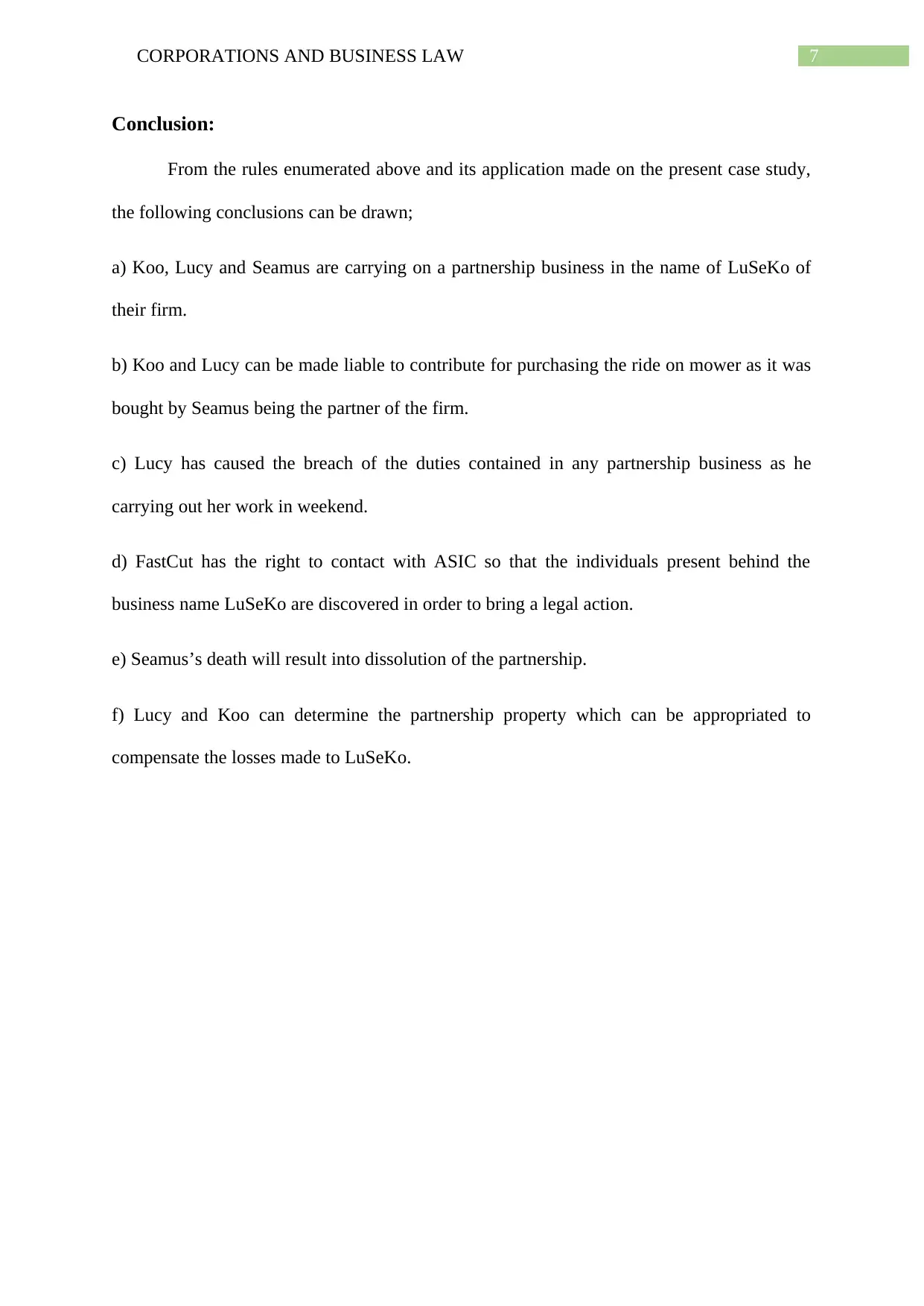
7CORPORATIONS AND BUSINESS LAW
Conclusion:
From the rules enumerated above and its application made on the present case study,
the following conclusions can be drawn;
a) Koo, Lucy and Seamus are carrying on a partnership business in the name of LuSeKo of
their firm.
b) Koo and Lucy can be made liable to contribute for purchasing the ride on mower as it was
bought by Seamus being the partner of the firm.
c) Lucy has caused the breach of the duties contained in any partnership business as he
carrying out her work in weekend.
d) FastCut has the right to contact with ASIC so that the individuals present behind the
business name LuSeKo are discovered in order to bring a legal action.
e) Seamus’s death will result into dissolution of the partnership.
f) Lucy and Koo can determine the partnership property which can be appropriated to
compensate the losses made to LuSeKo.
Conclusion:
From the rules enumerated above and its application made on the present case study,
the following conclusions can be drawn;
a) Koo, Lucy and Seamus are carrying on a partnership business in the name of LuSeKo of
their firm.
b) Koo and Lucy can be made liable to contribute for purchasing the ride on mower as it was
bought by Seamus being the partner of the firm.
c) Lucy has caused the breach of the duties contained in any partnership business as he
carrying out her work in weekend.
d) FastCut has the right to contact with ASIC so that the individuals present behind the
business name LuSeKo are discovered in order to bring a legal action.
e) Seamus’s death will result into dissolution of the partnership.
f) Lucy and Koo can determine the partnership property which can be appropriated to
compensate the losses made to LuSeKo.
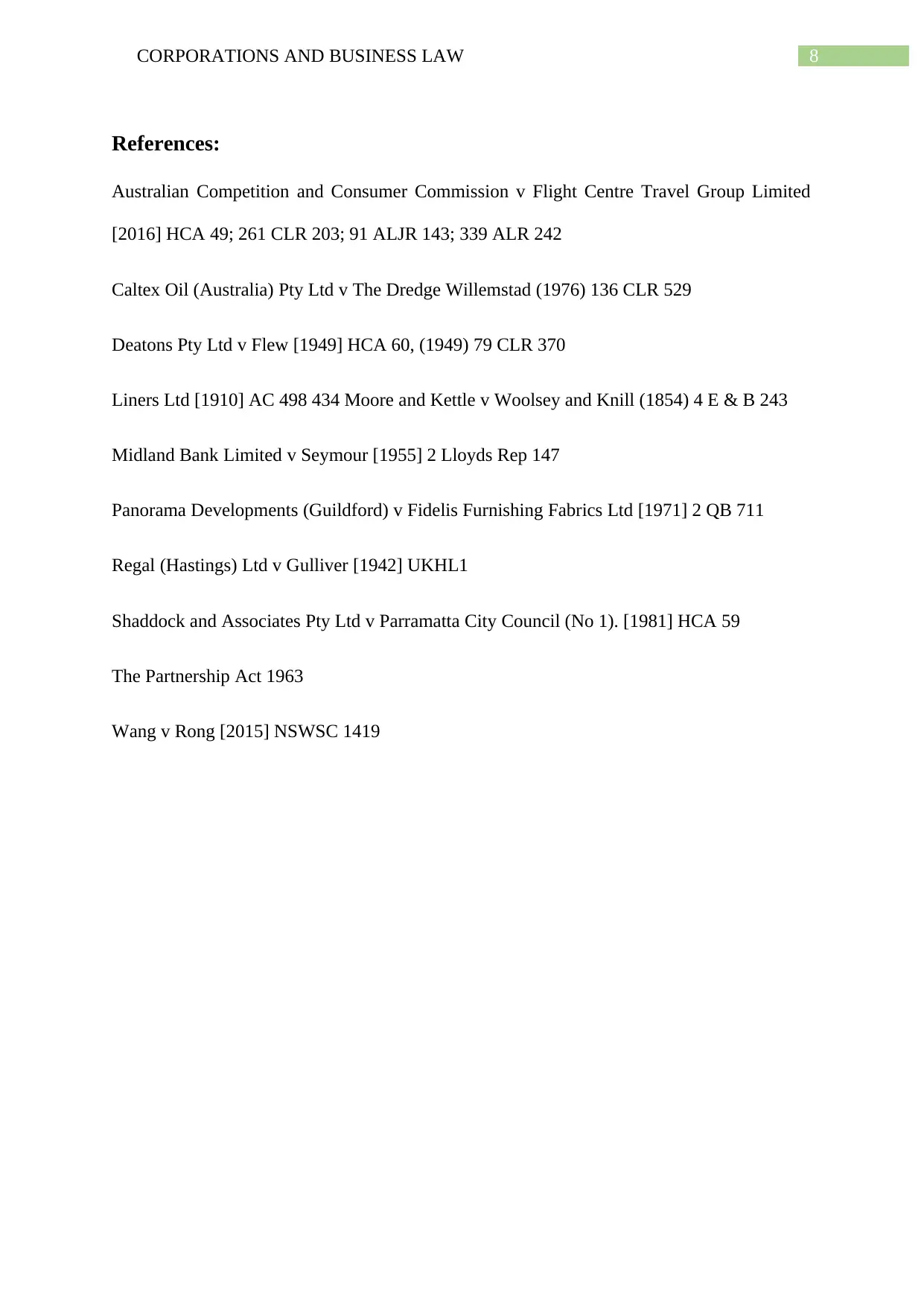
8CORPORATIONS AND BUSINESS LAW
References:
Australian Competition and Consumer Commission v Flight Centre Travel Group Limited
[2016] HCA 49; 261 CLR 203; 91 ALJR 143; 339 ALR 242
Caltex Oil (Australia) Pty Ltd v The Dredge Willemstad (1976) 136 CLR 529
Deatons Pty Ltd v Flew [1949] HCA 60, (1949) 79 CLR 370
Liners Ltd [1910] AC 498 434 Moore and Kettle v Woolsey and Knill (1854) 4 E & B 243
Midland Bank Limited v Seymour [1955] 2 Lloyds Rep 147
Panorama Developments (Guildford) v Fidelis Furnishing Fabrics Ltd [1971] 2 QB 711
Regal (Hastings) Ltd v Gulliver [1942] UKHL1
Shaddock and Associates Pty Ltd v Parramatta City Council (No 1). [1981] HCA 59
The Partnership Act 1963
Wang v Rong [2015] NSWSC 1419
References:
Australian Competition and Consumer Commission v Flight Centre Travel Group Limited
[2016] HCA 49; 261 CLR 203; 91 ALJR 143; 339 ALR 242
Caltex Oil (Australia) Pty Ltd v The Dredge Willemstad (1976) 136 CLR 529
Deatons Pty Ltd v Flew [1949] HCA 60, (1949) 79 CLR 370
Liners Ltd [1910] AC 498 434 Moore and Kettle v Woolsey and Knill (1854) 4 E & B 243
Midland Bank Limited v Seymour [1955] 2 Lloyds Rep 147
Panorama Developments (Guildford) v Fidelis Furnishing Fabrics Ltd [1971] 2 QB 711
Regal (Hastings) Ltd v Gulliver [1942] UKHL1
Shaddock and Associates Pty Ltd v Parramatta City Council (No 1). [1981] HCA 59
The Partnership Act 1963
Wang v Rong [2015] NSWSC 1419
⊘ This is a preview!⊘
Do you want full access?
Subscribe today to unlock all pages.

Trusted by 1+ million students worldwide
1 out of 9
Related Documents
Your All-in-One AI-Powered Toolkit for Academic Success.
+13062052269
info@desklib.com
Available 24*7 on WhatsApp / Email
![[object Object]](/_next/static/media/star-bottom.7253800d.svg)
Unlock your academic potential
Copyright © 2020–2025 A2Z Services. All Rights Reserved. Developed and managed by ZUCOL.





